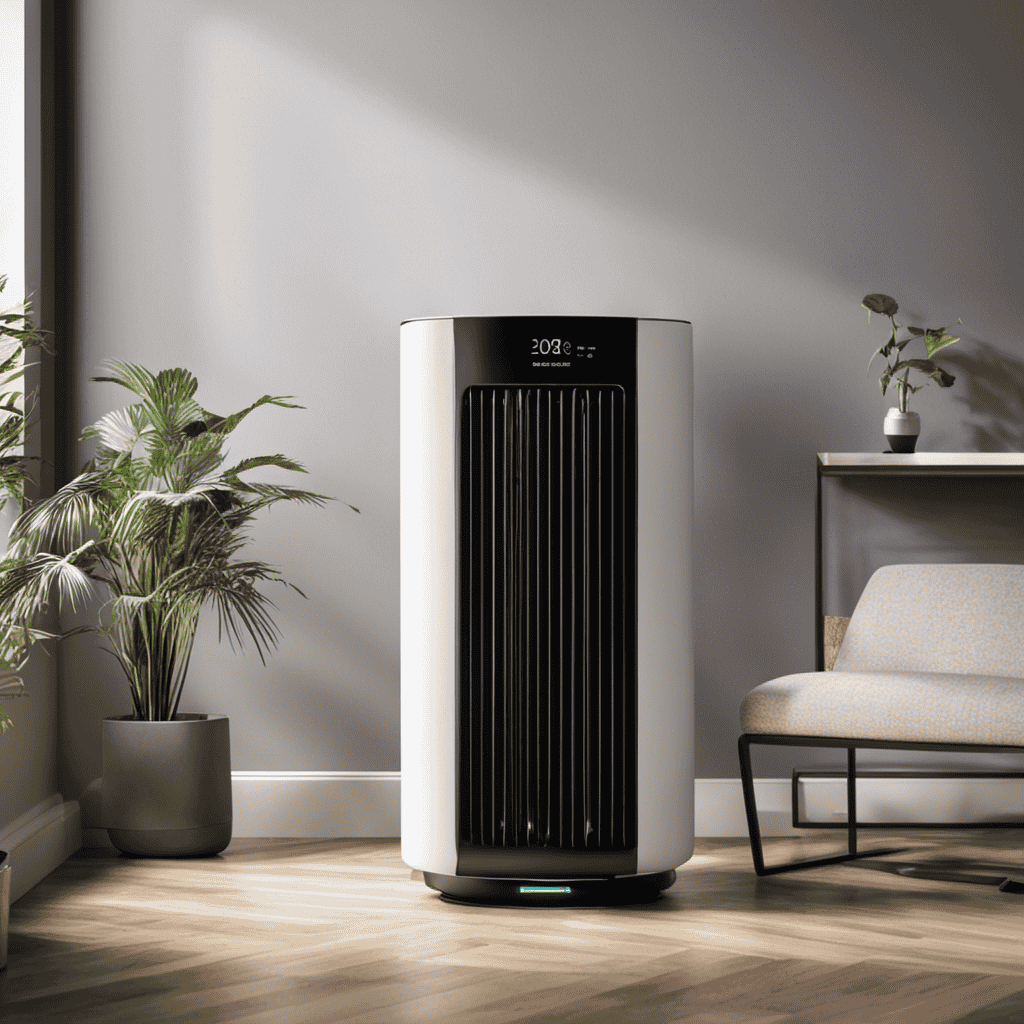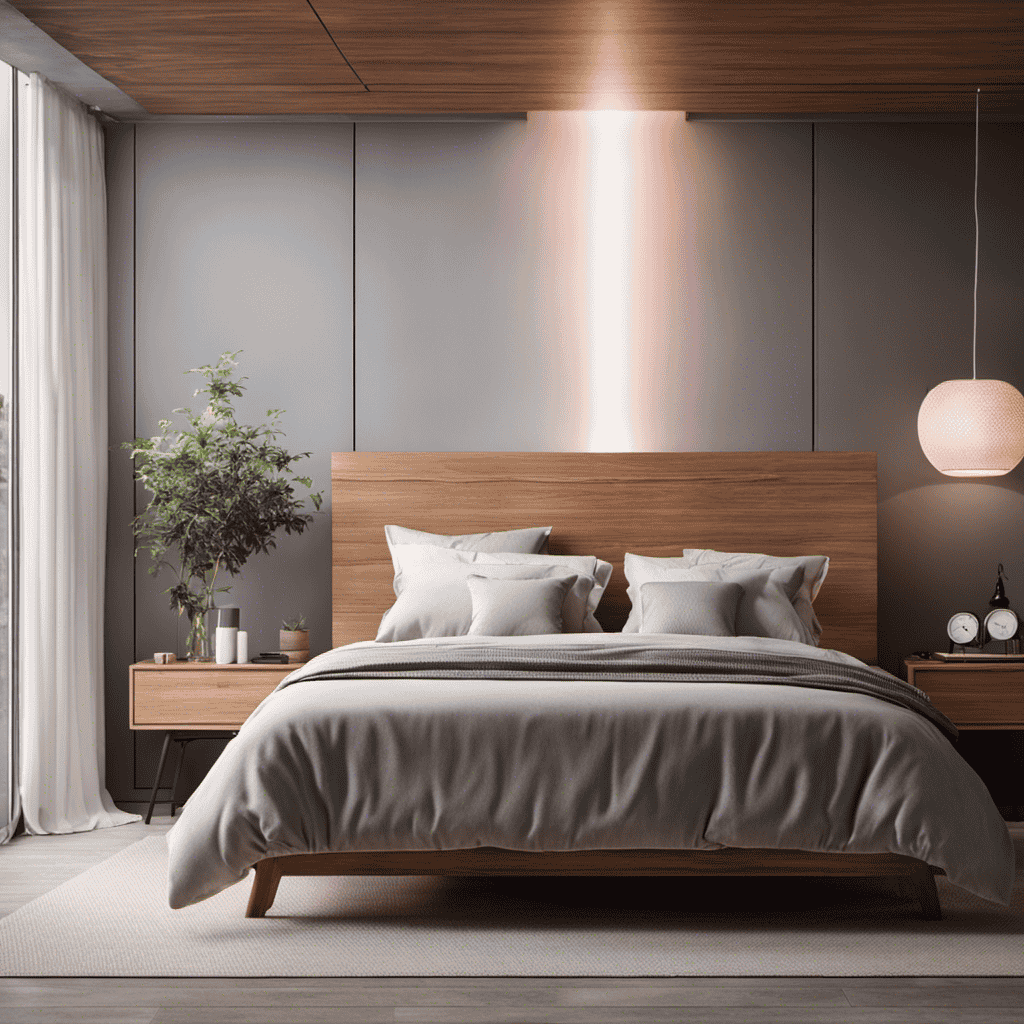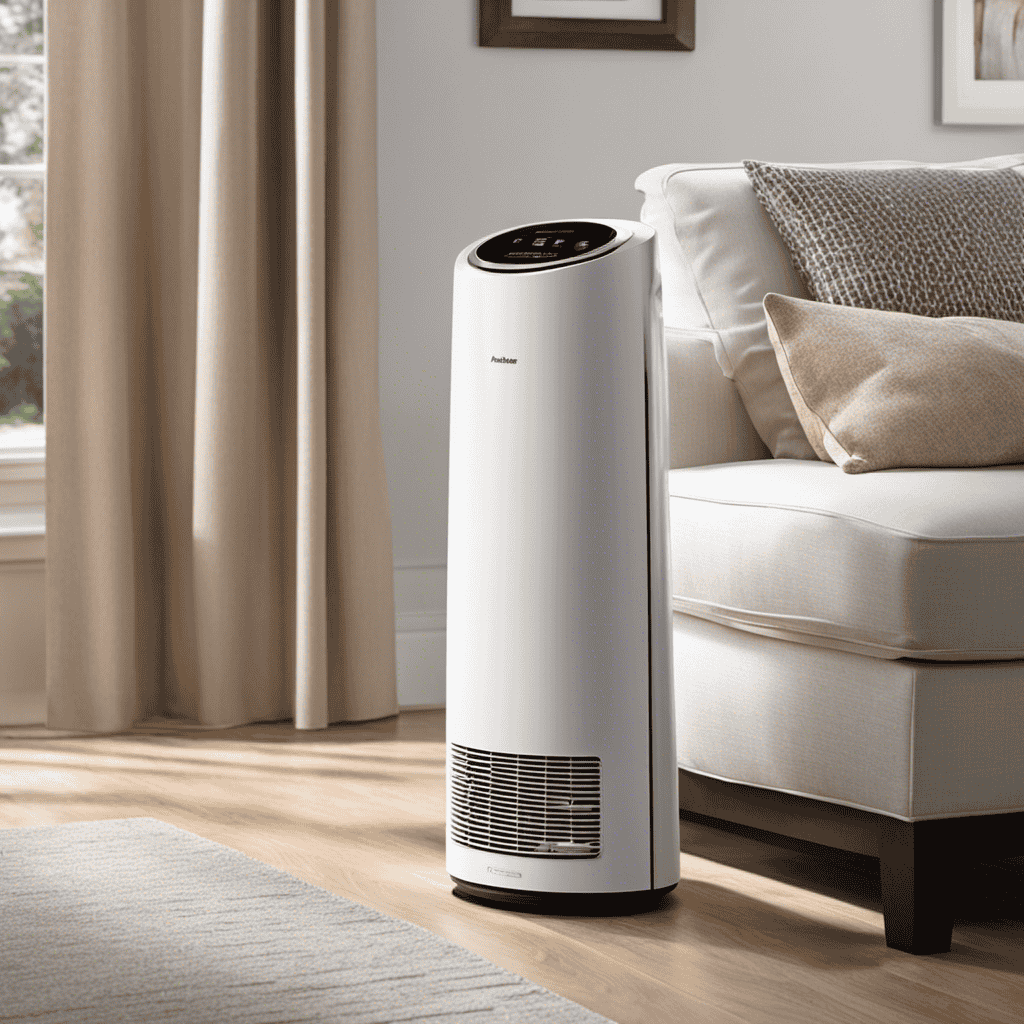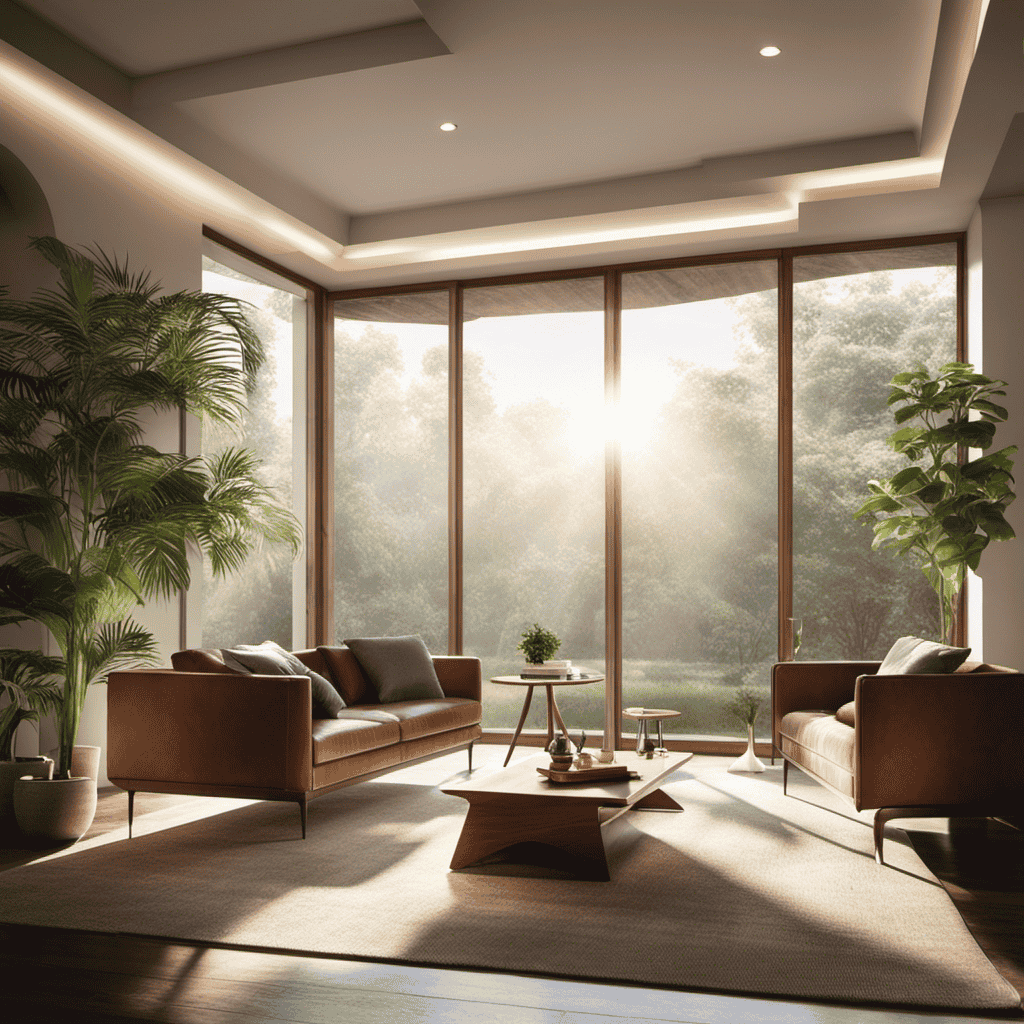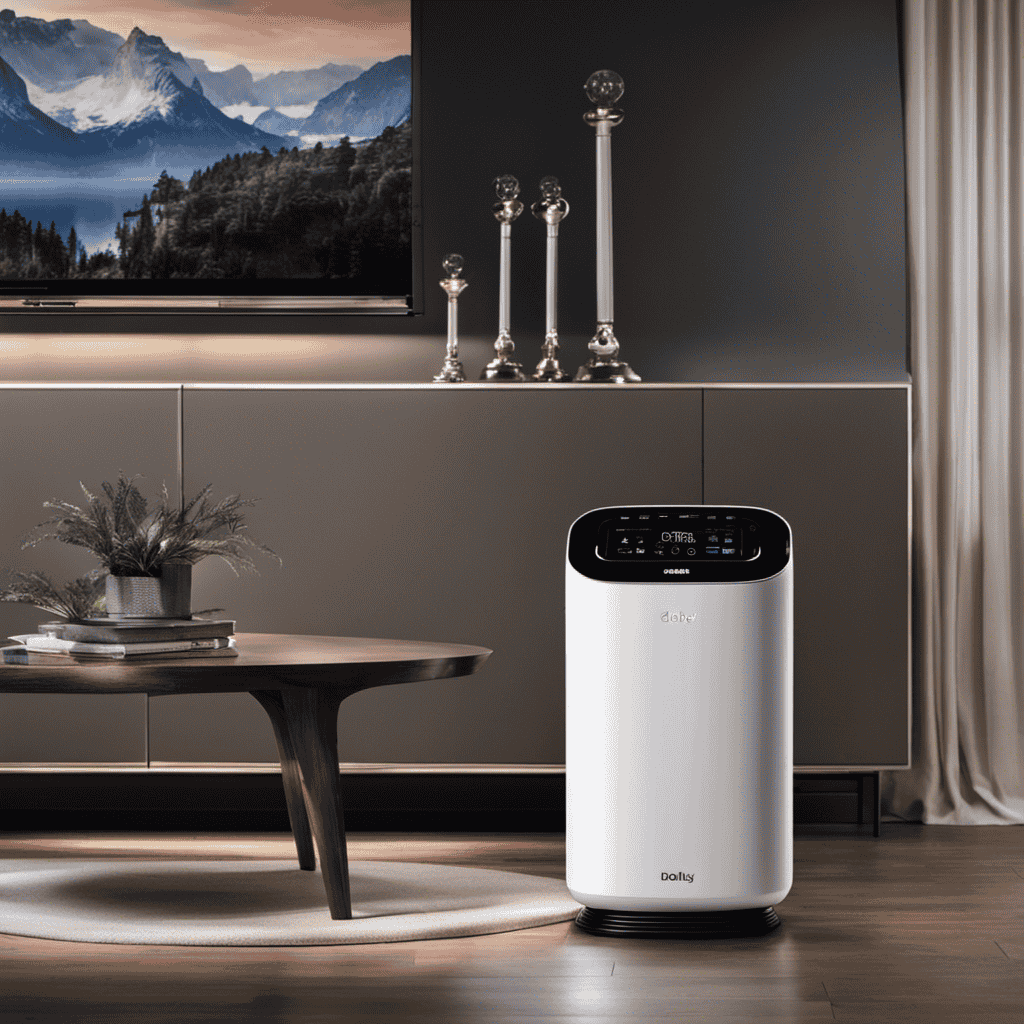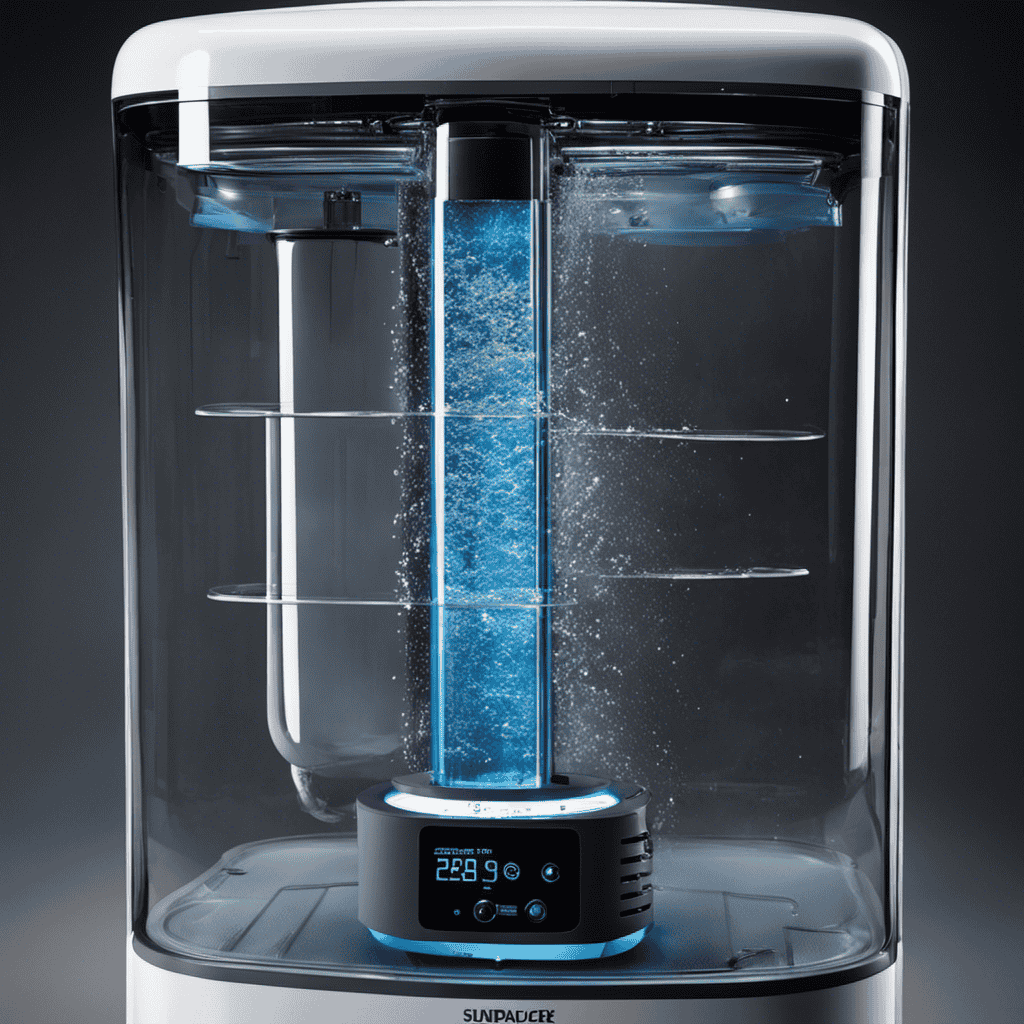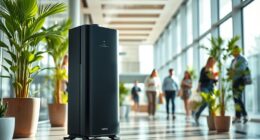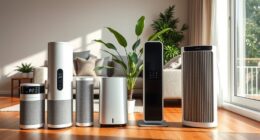While taking in the refreshing air of a forest, I find myself pondering how the air quality in my own home stacks up. With the increasing focus on indoor air quality, it is important to think about where you are placing your air purifier. Is it positioned correctly?
In this article, we will explore the importance of positioning an air purifier correctly, factors to consider, and expert recommendations for different rooms. Let’s uncover the secrets to achieving optimal indoor air purification.
Key Takeaways
- Direct airflow towards the center of the room for maximum effectiveness
- Circulate and filter air in all directions to remove pollutants
- Prevent stagnant pockets of air and promote better air circulation
- Avoid placing the purifier near sources of pollution that compromise efficiency
Importance of Proper Air Purifier Placement
Proper air purifier placement is crucial for ensuring optimal air quality in your home. By maximizing air purification, you can effectively remove harmful pollutants and allergens from the air, creating a healthier living environment.
To achieve this, it is important to consider a few key factors when positioning your air purifier.
First, make sure to place the purifier in a central location within the room to allow for maximum air circulation. This will help the purifier capture and filter the air more efficiently.
Additionally, keep the purifier away from any obstructions such as furniture or curtains, as these can block airflow and hinder its effectiveness.
Lastly, consider the size of the room and the airflow capacity of the purifier to ensure proper coverage.
By following these guidelines, you can optimize the performance of your air purifier and achieve cleaner, fresher air in your home.
In the next section, we will explore the factors to consider when positioning an air purifier in more detail.
Factors to Consider When Positioning an Air Purifier
Make sure to consider factors like room size, air circulation, and proximity to sources of pollution when positioning your air purifier.
Understanding air circulation is crucial in determining the optimal placement strategies for your air purifier. To effectively circulate clean air throughout the room, it is recommended to place the purifier in an area with good airflow. This could be near a window or a doorway, as these are usually areas where air enters or exits the room.
Additionally, avoid placing the purifier near sources of pollution, such as smoke or chemicals, as it may compromise its efficiency.
Understanding Airflow Patterns for Optimal Air Purification
When it comes to optimizing air purification, understanding ideal airflow directions and proper air purifier placement are key.
By directing the airflow in the right direction, we can ensure efficient removal of pollutants and allergens from the air.
Additionally, strategic placement of the air purifier can help maximize its effectiveness by targeting specific areas of concern within a room or space.
Ideal Airflow Directions
To ensure the best air purification, you’ll want to position the air purifier so that the airflow is directed towards the center of the room. This is because ideal airflow patterns play a crucial role in optimizing the effectiveness of air purifiers.
By directing the airflow towards the center of the room, the air purifier can efficiently circulate and filter the air in all directions, ensuring that the entire room benefits from the purification process. This technique allows the air purifier to capture and remove pollutants, allergens, and other contaminants present in the air.
Additionally, directing the airflow towards the center of the room helps to prevent stagnant pockets of air and promotes better air circulation. With this optimal purification technique, you can breathe cleaner and fresher air in your living space.
Now that we understand the importance of directing the airflow towards the center of the room for optimal air purification, let’s explore the next crucial aspect: air purifier placement.
Air Purifier Placement
Now that we’ve covered ideal airflow directions, let’s focus on where you should position your air purifier.
Optimal placement is crucial for the effective functioning of your purifier. One common mistake people make is placing the purifier against a wall or in a corner. This restricts airflow and reduces its efficiency. Instead, position your purifier in the center of the room, away from walls and furniture, to allow for proper air circulation.
Another mistake is placing the purifier near sources of pollution, such as windows or doors. This can cause the purifier to work harder and may not effectively clean the air. To ensure the best performance, keep the purifier at least a few feet away from potential sources of pollution.
In the next section, we will discuss the best placement options for different types of air purifiers.
Best Placement Options for Different Types of Air Purifiers
When it comes to choosing the best placement for your air purifier, there are two key factors to consider.
Firstly, you need to decide whether you want to place it on the wall or on the floor. Wall placement is ideal if you have limited floor space because it allows for better circulation and coverage. On the other hand, if you have more open space, placing the air purifier on the floor can provide more even distribution of clean air throughout the room.
Secondly, you should think about where to position the air purifier in relation to certain objects. It is generally recommended to place it near potential sources of pollutants, such as windows or doorways. This way, it can effectively capture and filter any pollutants that enter the room. However, it’s important to keep the air purifier away from any obstacles that could obstruct airflow.
Wall or Floor
The air purifier should be placed facing the wall or the floor, depending on your preference. When it comes to placement options, there are a few factors to consider:
-
Floor placement: Placing the air purifier on the floor can be beneficial as it allows for better coverage of the entire room. This is especially important if you have a larger space or if you want to target specific areas, such as near doors or windows.
-
Wall placement: Placing the air purifier near a wall can help create a more directed airflow. This can be useful if you want to focus on a specific area or if you have limited floor space. By facing the air purifier towards the wall, you can ensure that the purified air is circulated more effectively.
-
Ceiling placement: While not as common, ceiling placement can be an option for certain air purifiers. This allows for an even distribution of purified air throughout the room, as the unit is positioned at a higher point.
Considering these placement options, it is important to choose the one that best suits your needs and the layout of your space.
Now, let’s explore the next aspect of air purifier placement: near or far?
Near or Far?
Placing the air purifier closer to the source of pollutants can help improve its effectiveness. The location of the air purifier plays a crucial role in its ability to clean the air efficiently.
When deciding whether to place the air purifier near or far from the source of pollutants, it is important to consider the type of pollutants and the size of the area. If the source of pollutants is concentrated in a specific area, such as a kitchen or a smoking room, it is advisable to place the air purifier nearby. This allows the purifier to quickly capture and filter the pollutants before they spread.
However, if the pollutants are dispersed throughout a larger area, it may be more effective to place the air purifier farther away to ensure better air circulation and coverage.
The Effects of Improper Air Purifier Orientation
Improperly orienting your air purifier can negatively affect its ability to effectively clean the air in your home. When an air purifier is not properly oriented, it may not be able to effectively circulate the air and remove pollutants.
Here are some effects of improper air purifier orientation and the importance of proper air purifier placement:
-
Reduced air circulation: If the air purifier is facing a wall or obstructed by furniture, it may restrict the airflow and reduce its effectiveness in cleaning the air.
-
Inefficient pollutant removal: Improper orientation can lead to the air purifier not being able to capture pollutants effectively. This can result in poor indoor air quality and potential health issues.
-
Uneven distribution of clean air: Proper placement ensures that the clean, purified air is evenly distributed throughout the room, providing maximum benefits for all occupants.
To maximize the performance of your air purifier, it is crucial to follow the manufacturer’s instructions and place it in an open area, away from obstructions, ensuring optimal air circulation and pollutant removal.
Common Mistakes to Avoid When Positioning an Air Purifier
When it comes to maximizing the performance of an air purifier, there are several factors that can affect its efficiency. One common misconception is that simply placing the air purifier in any location will do the job. However, proper placement is crucial for the optimal functioning of an air purifier.
Here are some common mistakes to avoid when positioning an air purifier:
-
Placing it in a corner: While it may seem like a good idea to tuck the air purifier away in a corner, this can actually restrict airflow and reduce its effectiveness. It is best to position the purifier in an open area where it can circulate air more freely.
-
Blocking the intake or exhaust vents: Make sure to keep the intake and exhaust vents of the air purifier clear from obstructions such as furniture or curtains. Blocking these vents can hinder the airflow and reduce its ability to purify the air.
-
Neglecting the size of the room: Consider the size of the room when choosing the right air purifier. Using an undersized purifier for a large room will result in inefficient air cleaning, while using an oversized purifier for a small room will waste energy and may even cause discomfort.
How to Determine the Direction of Airflow in a Room
To determine the direction of airflow in a room, you can use a simple trick involving a tissue or a piece of paper. Hold the tissue or paper up in the air and observe its movement. Here are three things to keep in mind when trying this technique:
-
Understanding airflow mechanics: Air naturally moves from areas of high pressure to areas of low pressure. This means that if there is a source of air, such as an open window or a fan, the tissue or paper will move towards it.
-
Ventilation strategies: Determining the direction of airflow can help you optimize your ventilation strategies. By placing fans or air purifiers in the path of the airflow, you can effectively circulate and clean the air in the room.
-
Experimentation: It’s important to note that airflow can be influenced by many factors, such as obstacles or air conditioning systems. Therefore, it may be necessary to experiment with different placements of fans or air purifiers to achieve the desired airflow in the room.
Tips for Achieving Balanced Air Purification in Large Spaces
When it comes to achieving balanced air purification in large spaces, there are several key factors to consider.
First, proper placement of the air purifiers is essential for maximum effectiveness. This includes strategically positioning them in areas where air circulation is optimal and where pollutants are most likely to accumulate.
Additionally, deciding whether to use multiple units or just one depends on the size and layout of the space, as well as the specific air quality needs.
Lastly, regular maintenance and filter replacement are crucial to ensure that the air purifiers continue to perform at their best and effectively remove pollutants from the air.
Placement for Maximum Effectiveness
For maximum effectiveness, it’s important to face the air purifier towards the area that needs the most cleaning. This ensures that the purifier can efficiently remove airborne contaminants from the targeted space.
To further enhance the performance of your air purifier, consider the following placement tips:
-
Optimal distance: Place the air purifier at a recommended distance of about 6-10 feet away from the source of pollution. This allows the purifier to effectively capture and filter the pollutants without any hindrance.
-
Height placement: Position the air purifier at an elevated level, such as on a table or shelf, to maximize its coverage. This helps the purifier to draw in the contaminated air from a wider area, allowing it to clean a larger space more efficiently.
-
Avoid obstructions: Ensure that the air purifier is not obstructed by furniture or other objects. This allows for unobstructed airflow and ensures that the purifier can effectively circulate and clean the air in the room.
Multiple Units or One
If you’re considering purchasing multiple units, it’s important to assess the size and layout of your space to determine if one air purifier will suffice or if multiple units would be more effective.
While a single air purifier can effectively clean the air in a small room, larger spaces or spaces with multiple rooms may require multiple units strategically placed throughout. Multiple units can ensure that every corner of the space is covered and that the air is consistently purified.
Additionally, placing air purifiers strategically in areas where pollutants are most concentrated, such as near sources of allergens or pollutants, can further enhance their effectiveness. By considering the size of your space and placing multiple units strategically, you can maximize the benefits of air purification in your home or office.
Now, let’s discuss the important topic of maintenance and filter replacement.
Maintenance and Filter Replacement
Regular maintenance and filter replacement are crucial to ensure that your air purifier continues to effectively clean the air in your space. Here are some maintenance tips to help you keep your air purifier running at its best:
- Clean or replace the pre-filter regularly to prevent it from becoming clogged with larger particles.
- Check the filter lifespan and replace it as recommended by the manufacturer to maintain optimal performance.
- Vacuum the exterior of the air purifier to remove any dust or debris that may have accumulated.
Taking these maintenance steps will not only help prolong the lifespan of your air purifier but also ensure that it is working efficiently to remove pollutants from the air.
In the next section, we will explore the relationship between air purifier placement and indoor air quality, so you can make informed decisions about where to position your air purifier for maximum effectiveness.
The Relationship Between Air Purifier Placement and Indoor Air Quality
When placing your air purifier, make sure it is facing towards the area where you spend the most time. This is important because the effectiveness of the air purifier largely depends on its proper placement.
By positioning it in the area where you spend the most time, such as your bedroom or living room, you can maximize its benefits. A properly placed air purifier can help remove pollutants, allergens, and other harmful particles from the air, improving indoor air quality. It can reduce the presence of dust, pet dander, pollen, and even mold spores.
Additionally, placing the air purifier in the right direction ensures that the air is properly circulated and filtered throughout the room, enhancing its overall efficiency.
Expert Recommendations for Positioning Air Purifiers in Different Rooms
When it comes to positioning air purifiers in different rooms, expert recommendations are based on understanding airflow patterns to achieve balanced purification.
Here are some key points to consider:
-
Bedroom: Place the air purifier near the bed, preferably facing the center of the room. This ensures that the purified air is directed towards you during sleep.
-
Living room: Position the air purifier in a central location, facing the area where you spend the most time. This allows for better circulation of clean air throughout the room.
-
Kitchen: Place the air purifier near the cooking area, facing away from it. This helps to capture and remove cooking odors, smoke, and particles effectively.
Understanding these airflow patterns and strategically positioning your air purifier can enhance its efficiency in providing clean and healthy indoor air.
Remember to follow manufacturer’s instructions for optimal placement and maintenance to maximize its performance.
Frequently Asked Questions
Can I Place My Air Purifier on the Floor?
Yes, you can place your air purifier on the floor. However, it is important to consider the height of the purifier to ensure optimal air circulation and effectiveness in purifying the room.
Is It Better to Have Multiple Air Purifiers in One Room or One Air Purifier in Each Room?
Having multiple air purifiers in one room can help improve air quality more effectively than having just one per room. However, it’s important to consider the pros and cons, as well as choose the best air purifier for your home.
Should I Place My Air Purifier Near a Window or Door?
When it comes to air purifier placement, it’s important to consider the benefits of placing it near a window or door. This can help to capture outdoor pollutants and improve air circulation in the room.
Can I Place My Air Purifier Next to Other Electronic Devices?
Yes, you can place your air purifier next to other electronic devices. However, it is important to consider proper air purifier maintenance and avoid placing it near plants, as they can hinder its airflow and effectiveness.
Is It Necessary to Change the Position of My Air Purifier Regularly for Optimal Air Purification?
Changing the position of an air purifier regularly is not necessary for optimal air purification. However, it is important to regularly change the air purifier filters to ensure the best performance and reap the benefits of using an air purifier.
Conclusion
In conclusion, proper placement of an air purifier is crucial for optimal air purification and indoor air quality. While some may think it’s a simple task, the direction in which your air purifier faces can make a world of difference.
Remember, don’t just randomly plop it down and hope for the best! Consider factors like airflow patterns, room size, and the type of air purifier you’re using. And if you want a good laugh, just imagine your air purifier facing the wrong way, futilely attempting to clean the wall. Trust me, it’s not a pretty sight.
So, take a moment to position your air purifier correctly and breathe in that sweet, purified air with confidence!
